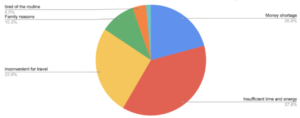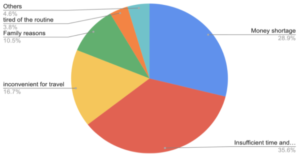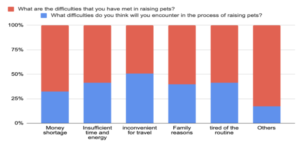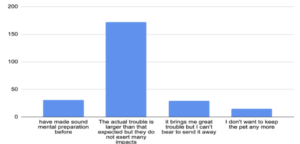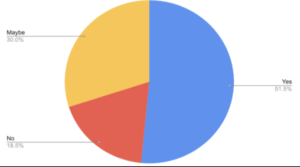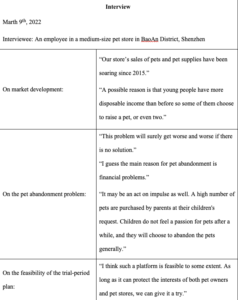Forever Companionship or Temporary Entertainment: Can “Nudge Theory” Decrease Pet Abandonment in China?

Abstract
Due to the expanding pet market and increasingly consumptive pet industry, the issue of pet abandonment has become more prevalent in China. The economic burdens and time restraints that come with owning a pet are often underestimated, leaving many pet owners to abandon their animals. This study focuses on how researchers may use the “nudge theory” to combat the ongoing problem of pet abandonment, primarily in the pet store model. The term “nudge” pertains to how positive opinions and indirect recommendations may influence the behavior and decisions of groups and individuals. The study aims to propose a viable business plan to reduce the rate of abandonment of cats and dogs in China from the perspective of pet owners.
Introduction:
Over the last ten years, the scale of the Chinese pet market has been increasing, and the consumption within the pet industry has grown rapidly. Looking solely at the cat and dog market, the scale of the Chinese pet consumption market reached one hundred seventy billion yuan in 2018.1 There were ninety-one million pets in China at that time.2 These numbers are still increasing dramatically. However, though more and more people own pets, a large portion of the Chinese population still view pets purely as entertainment, as if they were toys with little value.
In 2021, there was a lot of shocking news regarding pet issues in China. It should be noted here that the term “pet” within the context of this paper refers to domesticated animals such as cats and dogs. One example of these pet issues in China is the “living pet blind-box.” By definition, a “blind-box” is a type of packaging that keeps its contents hidden so the buyers have no idea what is inside. Many people like to purchase them for entertainment. The living pet blind-boxes had packaging that concealed live animals. Unfortunately, the delivery process for these living pet blind-boxes was very harmful to the pets, as the closed packaging exposed them to the risk of suffocation and extremely high temperatures for long periods of time.
Another shocking piece of news pertains to the public killings of cats and dogs. They were executed under the pretense of controlling the epidemic. However, there was no evidence that the animals had or were spreading Covid-19. In addition to this, there was no consent on behalf of their owners for these killings. An article written by Jiang Ye on China Digital Times commented on the news and questioned the attitudes of Chinese society towards pets: “Killing a dog at will, under the evil mirror of the epidemic, clearly reflects the indifference, numbness, cowardice, selfishness, narrow-mindedness, conservativeness, ignorance, rudeness, and barbarism of human nature. The way human beings treat pets now would be the way human beings treat themselves in the future.”3
In 2017, Professor Richard Thaler won the Nobel Prize in Economics by proposing the “nudge theory,” which is “any aspect of the choice architecture that alters people’s behavior in a predictable way without forbidding any options or significantly changing their economic incentives.”4 This theory guides people to behave in a specific pattern by providing them with incentives or default options.
The nudge theory is used frequently and can be applied in many situations. For instance, in the presentation of Personetics Technologies, nudge theory is applied to the model of the bank and analyzes the feasibility of its application. The showcase proposes three main ways as to how banks may use the nudge theory to help customers make better decisions.5 These specific applications of the nudge theory are capable of being used in the pet market since customers in the pet market also strive to avoid trouble and achieve goals with small steps—just like the customers in banks prefer to avoid insufficient balances and make “available-to-save” funds in their checking accounts.
To summarize, it is believed in this study that with the worsening situation of pet abandonment in China, a more practicable and effective solution should be found. The nudge theory has the potential to effectively combat pet abandonment since researchers could use it to indirectly influence consumers’ decisions. They may subtly encourage them to avoid impulse purchasing these animals by providing the customers with a new choice. Since the nudge theory does not change the customers’ economic incentives, it does not harm the interests of both pet owners and customers in transactions.
Therefore, the study will, based on the thinking of nudge theory, make pet stores a starting point and the incentive initiator, and propose a viable business plan to reduce the rate of pet abandonment from the root cause (i.e., pet owners).
Nowadays, many people make impulsive decisions when it comes to purchasing pets. A way to combat this is by increasing the amount of time that people spend thinking on the purchase, before going through with it. If done successfully, the pet abandonment rate would decrease due to a decrease in purchases. This study proposes a trial period through pet stores for potential pet owners to better equip them with more knowledge of the pet-raising process. If the customer finds that they are not fully prepared during and/or after the trial, they can then return the pets, thus reducing the rate of pet abandonment.
The first hypothesis that the study investigates is the idea that there is a contrast between the average customer’s expectation of being a pet owner versus the actual reality. This leads people to recognize that there are various obstacles and troubles that they might have overlooked prior to purchasing the animal. Therefore, after the trial period, customers may forfeit the idea of pet ownership. The second hypothesis proposes that people will react to incentives. It implies that people would have certain changes in their understanding of pet ownership and responsibility after these trials, which would alter their final decisions on having pets.
Literature Review:
Unfortunately, there is very little research in both China and abroad regarding the use of nudge theory to solve the problem of pet abandonment. Analysis in most of the relevant literature on the solutions remains vague and generalized in China. According to the Supreme People’s Procuratorate of China, as of now there exists no information or laws related to pet abandonment in China.
However, there is research on the regulation methods of pet abandonment in other countries as well as the application of the nudge theory in real life (as previously mentioned with the bank model). According to a report from People’s Daily, researchers analyzed how Germany, the United Kingdom, and other countries have proposed related laws and regulated people who were raising pets.6 These laws and regulations in other countries could be used as references for solving the pet abandonment problems in China. Additionally, researchers could combine these methods with the nudge theory to better guide people through the decision-making process.
Method:
The study planned to design a survey for two sample groups: people who have raised cats and dogs, and people who are willing to raise cats and dogs. The first sample group could offer insight into whether most people make sound psychological preparations and equip themselves with knowledge before raising cats and dogs. The second group could offer insight into whether the “nudging” plan was effective for potential customers. It was designed to investigate the following three aspects: the differences between people’s expectations and the difficult reality of raising pets, whether most people conducted the proper research to prepare themselves for pet ownership, and to what extent the public would accept the plan.
To gain a more in-depth understanding of the development of the pet industry in China, on March 9, 2022, an interview was conducted with a man who had been working at a pet store for almost nine years. The pet store he works at is mainly for cat and dog owners in nearby communities. The process of the interview was recorded so that direct and real information could be obtained in a convenient and fast manner. The interview provided a more practical understanding of how pet stores operate, and how this industry developed during the interview process, which helped inform the final business solution.
Results and Analysis:
In total, four hundred and fifty people answered the survey online. Four hundred and thirty-three of these responses were valid responses that could be used in the following analysis. There were two hundred and forty-seven samples from people who have raised pets, and another one hundred and eighty-six samples from people who are willing to raise pets. There were twelve questions in the survey, but the study primarily focused on four of them—as shown in the figures below.
In Figures 1 and 2, the questions answered were focused on the difficulties of raising pets by outlining possible expectations versus realities. When looking at the data, insufficient time spent with the animals accounted for a large proportion of the issues that pet owners either anticipated or encountered. In addition, when combining the two graphs to compare the differences in Figure 3, the data showed that the issues pet owners had anticipated were, in reality, disproportionate to the real issues they encountered . Therefore, by highlighting the differences that exist between expectations and actualities of raising pets, the survey proved the first hypothesis, and thus the necessity of the proposed trial period.
“What difficulties do you think you will encounter in the process of raising pets?”
Note: This pie chart shows the distribution of expectations and assumptions about the difficulties of owning pets by people who are willing to raise pets.
“What are the difficulties that you have met in raising pets?”
Note: The graph illustrates the distribution of difficulties of raising pets in reality.
Comparison for data in Figure 1 and Figure 2
Note. This bar chart combines the data from Figure 1 and Figure 2, thus illustrating the differences between people’s expectations and the reality of raising pets.
The next survey question examines people’s reactions to being faced with difficulties. Figure 4 , is a histogram which visualizes the responses to this question. It emphasizes that most of those surveyed consider the actual difficulties of pet ownership to be more significant than expected. It is likely that people thought about the difficulties of raising a pet prior to purchasing but failed to estimate all these hardships due to a lack of experience. This problem could be attributed to multiple factors, including the owner being a first-time owner, the owner having had little knowledge of pets before purchase, and the nature of the decision to own a pet (i.e., whether the pet was an impulse purchase). The “greater-than-expected” difficulties in raising pets could possibly lead the pet owners to become frustrated or bored, all of which could result in a higher likelihood of pet abandonment.
“What kind of mental activities do you have when you encounter the aforesaid troubles?”
Note: The histogram displays the reactions of people who have raised pets when they encountered troubles and/or obstacles.
In Figure 5, participants of the survey were asked whether the public would accept the trial-period plan for pet stores first . About half of the responses were positive , demonstrating both a potential willingness by the public to engage with this plan, as well as the need to examine the possibleflaws and deficiencies that the negative responses may be anticipating. In future surveys, issues like pets’ safety and the professionalism of customers could be considered.
“If there is a trial provided by stores so that people can have the opportunity to experience pet raising before purchasing, would you be willing to try the trial first before purchasing?”
Note. This chart shows the acceptance of the trial raising plan in public.
Table 1 offers some direct quotes from the interviewed pet shop owner. He shared his point of view on the pet abandonment issues and his opinion about the feasibility of the plan.
Table 1
Note: This table displays some quotations from the interviewee who works at a pet store in Shenzhen, China.
Conclusion:
This study found that pet owners were not equipped with certain knowledge reserves and did not make certain mental preparations before purchasing and raising their pets. Therefore, many people may choose to abandon their pets, contributing to an increased population of stray pets, which can become a serious social problem if left unchecked. Thus, there is an evident need for a solution, such as the trial-period plan proposed. Both the survey and the interview showed that this plan had the potential to be accepted by the public, but also revealed that there are some problems existing in this plan that will need to be addressed.
There is further work needed to be done to improve the trial-period plan or to find a better way to solve the pet abandonment problem in China. A real-world application of the trial-period plan could offer more insight into possible improvements and adaptations that the plan could undergo. In the future, the trial-period plan should be more thorough and systematic. For example, the plan might be changed to include details about how to attract customers to try the plan first, and offer ‘after-sale’ services for pet customers. It is also important to consider more diversified solutions in the nudge theory, or even in other areas. The final purpose of this research is to solve the problem of pet abandonment, and these options are promising, but not inherently exclusive, solutions.
Sources
1. The Paper. “Market size of pet-related businesses in urban China from 2011 to 2021 (in billion yuan).” Chart. January 21, 2022. Statista. Accessed March 03, 2023. https://www.statista.com/statistics/765681/china-pet-market-size/.
2. The Paper. “Number of domestic cats and dogs kept as pets in urban households in China from 2017 to 2021 (in millions).” Chart. January 21, 2022. Statista. Accessed March 03, 2023. https://www.statista.com/statistics/1196715/china-number-of-domestic-dogs-and-cats-kept-as-pets/.
3. Jiang Ye将爷. (2022, Apr 06). “Rengezhi: Yizhi Corgi Beishasi Zai Shanghai Jietou”人格志|一只柯基被杀死在上海街头 [Personality: A corgi was killed on the streets of Shanghai] China Digital Times. https://chinadigitaltimes.net/chinese/679166.html.
4. Thaler, R. H., & Sunstein, C. R. (2008). Nudge: Improving decisions about health, wealth, and happiness. New Haven, Conn: Yale University Press.
5. Personetics Technologies. (2017, Oct 20). Personetics to showcase AI-powered banking applications of ‘nudge theory’ at Money20/20: By presenting consumers with small steps that require little effort and are easy to understand, banks can ‘nudge’ them towards better financial decisions. PR Newswire. https://www.prnewswire.com/news-releases/personetics-to-showcase-ai-powered-banking-applications-of-nudge-theory-at-money2020-651911993.html.
6. Hua Fang花放, Qiang Wei强薇, Zhao Yipu赵益普, & Liu Junguo刘军国. (2021, Jan 29). “Chongwu Siyang Xugongtong Zunshou Yangede Falvguifan, Geguo Shi Ruhe Zuode?” 宠物饲养须共同遵守严格的法律规范, 各国是如何做的?[Strict legal norms about keeping pets should be followed, so how are countries regulated?] People’s Daily. http://www.chinanews.com.cn/gn/2021/01-29/9399361.shtml.
Jacobetty, R., Lopes, D., Fatjó, J., Bowen, J., & Rodrigues, D. L. (2019). Psychological correlates of attitudes toward pet relinquishment and of actual pet relinquishment: The role of pragmatism and obligation. Animals, 10(1), 63. http://dx.doi.org/10.3390/ani10010063.
Schmidt, A. (2017). The Power to Nudge. American Political Science Review, 111(2), 404-417. doi:10.1017/S0003055417000028

